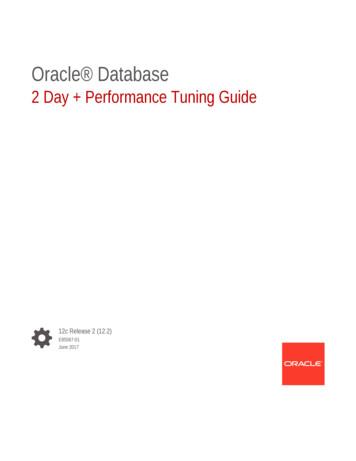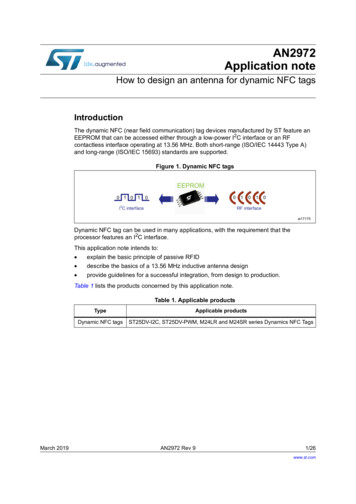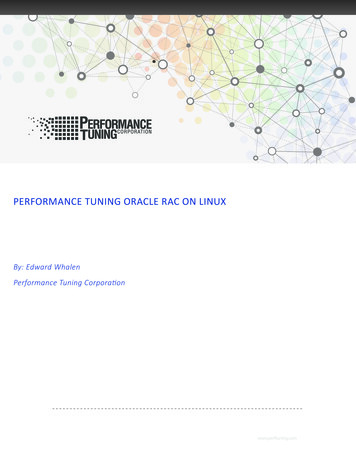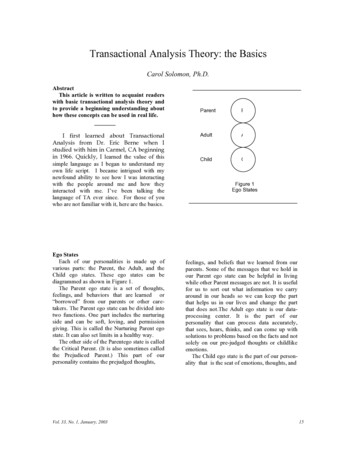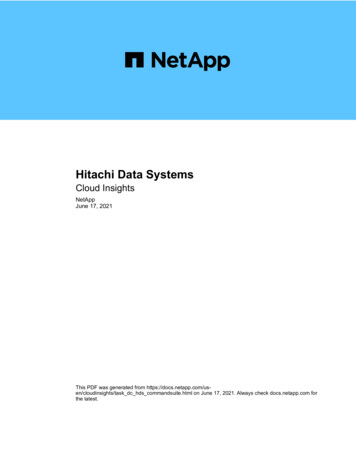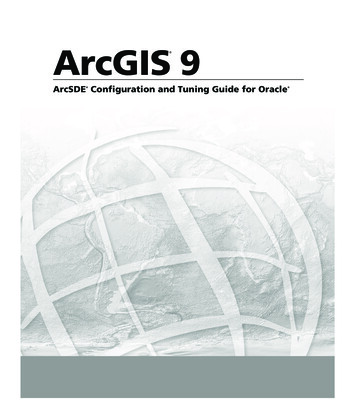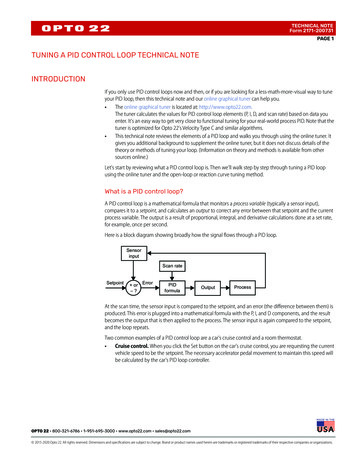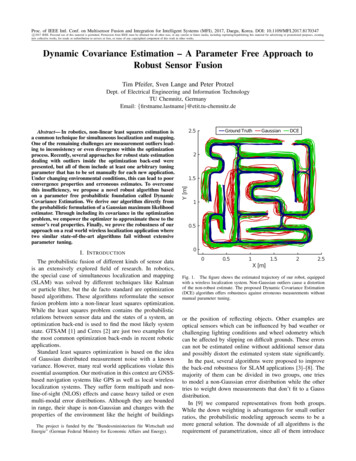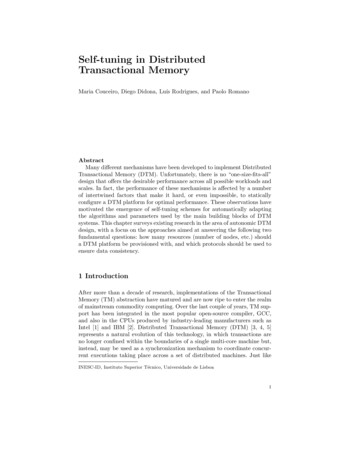
Transcription
Self-tuning in DistributedTransactional MemoryMaria Couceiro, Diego Didona, Luı́s Rodrigues, and Paolo RomanoAbstractMany different mechanisms have been developed to implement DistributedTransactional Memory (DTM). Unfortunately, there is no “one-size-fits-all”design that offers the desirable performance across all possible workloads andscales. In fact, the performance of these mechanisms is affected by a numberof intertwined factors that make it hard, or even impossible, to staticallyconfigure a DTM platform for optimal performance. These observations havemotivated the emergence of self-tuning schemes for automatically adaptingthe algorithms and parameters used by the main building blocks of DTMsystems. This chapter surveys existing research in the area of autonomic DTMdesign, with a focus on the approaches aimed at answering the following twofundamental questions: how many resources (number of nodes, etc.) shoulda DTM platform be provisioned with, and which protocols should be used toensure data consistency.1 IntroductionAfter more than a decade of research, implementations of the TransactionalMemory (TM) abstraction have matured and are now ripe to enter the realmof mainstream commodity computing. Over the last couple of years, TM support has been integrated in the most popular open-source compiler, GCC,and also in the CPUs produced by industry-leading manufacturers such asIntel [1] and IBM [2]. Distributed Transactional Memory (DTM) [3, 4, 5]represents a natural evolution of this technology, in which transactions areno longer confined within the boundaries of a single multi-core machine but,instead, may be used as a synchronization mechanism to coordinate concurrent executions taking place across a set of distributed machines. Just likeINESC-ID, Instituto Superior Técnico, Universidade de Lisboa1
2Maria Couceiro, Diego Didona, Luı́s Rodrigues, and Paolo RomanoTM have drawn their fundamental motivation in the advent of multi-corecomputing, the need for identifying simple, yet powerful and general programming models for the cloud is probably one of the key factors that havegarnered growing research interest in the area of DTM over the last years [6].Another major driver underlying existing research efforts in the area of DTMis fault-tolerance: as TM-based applications are expected to turn mainstreamin the short term, it becomes imperative to devise efficient mechanisms capable of replicating the state of a TM system across a set of distributed nodesin order to ensure their consistency and high-availability despite the failuresof individual nodes [7, 8].From the existing literature in the area of DTM, it can be observed that thedesign space of DTM platforms is very large and encompasses many complexissues, such as data placement and caching policies, replication protocols,concurrency control mechanisms, and group communication support, justto name a few. The performance of these fundamental building blocks ofa DTM is affected by multiple intertwined factors. This has motivated thedevelopment of a wide range of alternative implementations, each exploringa different trade-off in the design space and optimized for different workloadtypes, platform’s scales, and deployment scenarios. As a result, the body ofliterature on DTM encompasses solutions tailored for read-intensive [7] vsconflict-prone [9, 10] workloads, replication mechanisms optimized for smallclusters [11], large scale data centers [12, 13], as well as approaches specificallytargeting geographically distributed DTM platforms [3].One of the key conclusions that can be easily drawn by analyzing the results above is that there is no “one-size-fits-all” solution that can provideoptimal performance across all possible workloads and scales of the platform. This represents a major obstacle for the adoption of DTM systems inthe cloud, which bases its success precisely in its ability to adapt the typeand amount of provisioned resources in an elastic fashion depending on thecurrent applications’ needs. Besides, a DTM encompasses an ecosystem ofcomplex subcomponents whose performances are governed by a plethora ofparameters: manually identifying the optimal tuning of these parameters canbe a daunting task even when applications are faced with static workloadsand fixed deployments. Guaranteeing optimal efficiency in presence of a timevarying operational envelope, as typically occurs in cloud computing environments, requires to adjust these parameters in a dynamic fashion — atask that is arguably extremely onerous, if not impossible, without the aidof dedicated self-tuning mechanisms.This is precisely the focus of this chapter, in which we dissect the problemof architecting self-tuning mechanisms for DTM platforms, with a specialemphasis on solutions that tackle the following two fundamental issues: elastic scaling: DTM systems can be deployed over platforms of differentscales, encompassing machines with different computational capacitiesinterconnected via communication networks exhibiting diverse performances. Hence, a fundamental question that needs to be addressed when
Self-tuning Distributed Transactional Memories3architecting a DTM-based application is how many and what types of resources (number of nodes, their configuration, etc.) should be employed(e.g., acquired from an underlying IaaS (Infrastructure as a Service) cloudprovider) in order to ensure predetermined performance and reliabilitylevels. In cloud computing environments, where resources can be dispensed elastically, this is not a one-off problem, but rather a real-timeoptimization problem. Its optimal solution requires not only to estimatethe performance of applications when deployed over infrastructures ofdifferent scale and types, but also to encompass economical aspects (e.g.,by comparing the cost of a DTM deployment over a large number ofrelatively slow nodes against a deployment on a smaller number of morepowerful machines) as well as issues related to the on-line reconfigurationof the platform (namely, how to rearrange data after scaling); adapting the data consistency protocol: the literature on data consistencyprotocols for distributed and replicated transactional systems is a quiteprolific one. Existing approaches explore a number of different designchoices, concerning aspects such as whether to execute transactions onall nodes (as in active replication [14]) or executing in just one replicaand only propagating the transaction’s updates (a.k.a. deferred updateschemes [15]), how to implement transaction validation [16], and whetherto use distributed locking [17] vs total order communication protocols [18]to serialize transactions. This has motivated research aimed at supporting the automatic switching between multiple data consistency protocols,and, in some cases even the simultaneous coexistence of different protocols. The key challenges addressed in these works are related to how topreserve consistency despite the (possibly concurrent) employment of alternative consistency protocols, as well as to the identification of the beststrategy to adopt given the current workload and system’s characteristics.The remainder of this chapter is structured as follows. We first provide,in Section 2, an overview of the main building blocks encompassing typicalDTM architectures, and illustrate some of the key choices at the basis of theirdesign. Next, in Section 3, we identify the DTM components that wouldbenefit the most from the employment of adaptive, self-tuning designs. InSection 4, we provide background on the main methodologies employed inthe literature to decide when to trigger an adaptation and to predict whichamong the available strategies to adopt. In Section 5 we focus on elasticscaling, and in Section 6 we discuss adaptation of the consistency protocols.Finally, Section 7 concludes the paper.2 Background on DTMThis section is devoted to overview on the key mechanisms that are encompassed by typical DTM architectures. It should be noted that the discussion
4Maria Couceiro, Diego Didona, Luı́s Rodrigues, and Paolo 'on*System*Fig. 1 High level architecture of typical DTM platforms (single node).that follows does not aim at providing a thorough and exhaustive surveyof existing DTM designs, but rather to facilitate the description of the selftuning DTM systems described in the remainder of this chapter.The diagram in Figure 1 depicts the high level architecture of a typicalDTM platform, illustrating the key building blocks that compose the softwarestack of this type of system.DTM API. At their top most layer, existing DTM platforms expose APIsanalogous to those provided by non-distributed TMs that allow to define aset of accesses to in-memory data to be performed within an atomic transaction. The actual API exposed by a DTM is ultimately influenced by the datamodel that it adopts; the range of data models explored in the DTM literature includes, besides the object-based [7] and word-based [5] ones (typicallyemployed in non-distributed TMs), also popular alternatives in the NoSQLdomain, like the key-value [13, 19] model. Certain DTM platforms [20, 21]that support partial replication schemes (i.e., which do not replicate data atevery replica of the system) provide also dedicated API support to influencethe policies employed to determine the placement of data (and its replicas)across the nodes of the system, with the goal of enhancing the data localityachieved by DTM applications. These include programmatic mechanisms toensure the co-location of data items [21] or to provide the data placementservice with semantic information (like the data item’s type and the relationsin which it is involved) concerning the data access patterns generated by thenodes of the platform [20].Data Placement Service. The data placement service, as the name suggests, is responsible for locating the nodes that maintain (replicas of) the data
Self-tuning Distributed Transactional Memories5items accessed during the transaction execution. This module is required exclusively in case the DTM platform adopts a partial replication scheme (asin fully replicated systems each node maintain a replica of every data item),although certain DTM platforms may rely on analogous abstractions to establish ownership privileges of nodes on data items [21]. The actual implementation of this service is strongly affected by the transaction executionmodel embraced by the DTM, which can be either control-flow or data-flow.In control-flow systems data items are statically assigned (unless the platform is subject to elastic scaling) to the nodes of the platform, which retrievenon-local data items via RPC. In data-flow systems, conversely, transactionsare immobile and objects are dynamically migrated to invoking transactionalnodes. As in the control-flow model the placement of data is static, severalcontrol-flow DTM systems [21, 22, 12] adopt simple policies based on consistent hashing [23]. This technique, which essentially maps data items tonodes of the platform randomly via the use of a hash function, has the desirable properties of executing data items look ups locally (i.e., the nodes thatreplicate a given data item can be identified by computing the hash of itsidentifier) and achieving a good balance in the data distribution. Data-flowDTMs, on the other hand, rely on ad-hoc (distributed) directory or cache coherence protocols, such as the Arrow [24] or the Ballistic [25] protocols. Theseprotocols require that, in order for a node to access a data item, it must firstacquire its ownership (which implies locating the current data item owner).As a result, data-flow models can introduce additional network hops alongthe critical path of execution of transactions with respect to control-flow solutions (that do not allow migration of data). On the pro-side, by dynamicallymoving the ownership of items to the nodes that access them, data-flow systems can spontaneously lead to data placement strategies achieving betterlocality than static policies, like consistent hashing, supported exclusivelyby control-flow systems. A detailed discussion on control-flow and data-flowmodels, as well as on systems adopting these models, can be found in Chapter16.Transaction Dispatcher. The transaction dispatcher is a component presentin several DTM platforms [10, 5, 26], and is in charge of determining whetherthe execution of a transaction should take place on the node that generated it,on a different one, or even by all nodes in the platform. This decision can bedriven by different rationales, such as reducing data contention [26] or enhancing data locality [10, 5, 21]. In order to support the migration and execution ofentire transactions at remote nodes, the transaction dispatching mechanismtypically requires ad-hoc support at the DTM API layer in order to ensureproper encapsulation of the transaction logic, i.e., a function/procedure encoded in a programming language, and of its input parameters (using classicRPI mechanisms).Local STM. As for the local data stores, existing DTM platforms typically
6Maria Couceiro, Diego Didona, Luı́s Rodrigues, and Paolo Romanoleverage on state of the art local STMs, which implement efficient concurrencycontrol algorithms optimized for modern multi-core architectures [7, 11, 9,27].Cache for Remote Data. Some partially replicated DTM platforms [28,21] cache frequently accessed remote data items, and update them usinglazy/asynchronous invalidation strategies. Clearly, it must be possible to manipulate also cached data without breaking consistency: therefore they aremaintained in memory and their manipulation is subdued to some form ofconcurrency control. However, cached data need typically to be associatedwith different meta-data and managed with different rules than the datastored in the local STM (whose ownership can be established via the dataplacement service). As a consequence, cached data are normally maintainedin separate in-memory structures.Distributed Consistency Protocol. Clearly, the data accesses performedby local transactions need to be synchronized with those issued by transactions executing at different nodes. The responsibility of this task is delegatedto a distributed consistency protocol, which is ultimately responsible for enforcing the consistency guarantees ensured by the DTM platform. The literature on DTM (and more in general on distributed transactional platforms,e.g., distributed DBMS) has explored a number of alternative consistencylevels, like 1-copy serializability [13], virtual world consistency [9], extendedupdate serializability [12] and parallel SI [29]. Clearly, the choice of the consistency criterion has a strong impact on the design of the underlying distributed consistency protocol. Another factor that has a key impact on thedistributed consistency protocol is whether the system employs full or partialreplication. In fully replicated DTM platforms, in fact, once the transactionserialization order is established (typically by means of a consensus or atomicbroadcast service [7]), the nodes can determine the outcome of committingtransactions locally (by validating their read-set with respect to the mostrecent committed version). Conversely, in partially replicated DTM systems,some sort of 2PC-like agreement is unavoidable, as the snapshot accessed by acommitting transaction needs to be validated, in general, by multiple nodes,which must certify the freshness of the transaction’s snapshot with respect tothe locally stored authoritative copies of data. Over the last decades, a vastliterature on distributed consistency protocols for transactional systems hasemerged [15, 30, 31]. A possible taxonomy of existing solutions is reported inFigure 2.Single-master. In single master schemes, also known as primary backup, writetransactions are executed exclusively at a single node (also called master orprimary), whereas the remaining replicas can only run read-only transactions [32]. Upon failure of the master, a backup replica is elected to becomethe new master.
Self-tuning Distributed Transactional Memories7Consistency protocolSingle Master(Primary Backup)[32]Multi MasterTO basedCertification[7, 36, 37]2PC based[12, 21]State Machine Replication[13, 35]Fig. 2 Taxonomy for consistency protocols in transactional systems.Note that, as the write transactions can be serialized locally by the master using its local concurrency control algorithm, this approach can rely on asimpler replica synchronization scheme with respect to multi-master solutions(as we will see shortly). On the down side, the throughput of write transactions does not clearly scale up with the number of nodes in the system, whichmakes the master prone to become the system bottleneck.Multi-master. Multi-master schemes, on the other hand, are typically morescalable as transactions can be processed on all nodes. There are two types ofsynchronizing the accesses to data: eager and lazy. The first relies on a remotesynchronization phase upon each (read/write) access, which normally resultsin very poor performance results [33].Conversely, the lazy approach defersreplica synchronization till the commit time, which is when the transactionis finally validated. Lazy multi-master schemes can be classified based onwhether they rely on Atomic Commit Protocols (such as Two-Phase Commit)or Total Order (TO) [34] broadcast/multicast schemes to determine the globalserialization order of transactions.Two-Phase Commit. In solutions based on Two-Phase Commit (2PC), transactions attempt to atomically acquire locks at all nodes that maintain dataaccessed by the transaction. Even though these schemes normally incur inminor communication overheads with respect to those relying on TO, these
8Maria Couceiro, Diego Didona, Luı́s Rodrigues, and Paolo Romanosolutions are well known to suffer of scalability problems due to the rapidgrowth of the distributed deadlock rate as the number of replicas in the system grows [17].Total Order based schemes. Conversely, TO-based replication is a family of(distributed) deadlock-free algorithms that serializes transactions accordingto the total order established by a TO service [34]. These solutions can bedistinguished into two further classes: state machine replication and certification.State Machine Replication. In the state machine replication [14, 35], all replicas1 execute the same set of transactions in the same order. The transactionsare shipped to all replicas using total order broadcast and, consequently, allreplicas receive transactions in the same order and execute them in that order.However, both transactions and validation scheme must be fully deterministicso that all replicas begin and finish transactions in the same state.Certification. Unlike State Machine Replication, certification based techniques undertake a speculative approach, which can achieve higher scalability,in low conflict workloads, by fully executing the transaction only at one node.This means that different transactions may be executed on different replicasconcurrently. If the transaction aborts during its execution, no further coordination is required. However, if the transaction is ready to commit, atransaction validation phase is triggered in order to certify that it has notaccessed stale items. The information exchanged to certify transactions variesdepending on the considered certification protocol (e.g., non-voting [36], voting [37] or bloom-filter based [7]), but the certification request is disseminatedby means of a TO broadcast service that targets all the nodes that maintainreplicas of the data items accessed by the transaction. In case of partial replication, as already mentioned, this certification phase may have to involve avoting phase to gather positive acknowledgements from at least one replicaof each data item accessed within the transaction; in this case the messagepattern of the distributed consistency protocols coincides with the one of the2PC scheme, in which the prepare messages are disseminated using a TOservice.3 What should be self-tuned in a DTM?As it clearly emerges from the discussion in the previous section, the designand configuration space of DTM is quite vast, and there are several components in the DTM stack whose setting and parametrization has a strong1This technique has been proposed for fully replicated systems.
Self-tuning Distributed Transactional Memories9impact on DTM performance. Indeed, performance of a DTM applicationare driven by complex non-linear dynamics stemming from the intertwinedeffects of workload’s resource utilization (e.g., in terms of CPU and network bandwidth), data access pattern (e.g., data contention and locality),inter-nodes communication (e.g., for remote read operations) and distributedsynchronization (e.g., for committing transactions).Typical Key Performance Indicators (KPIs) of a DTM are general purposemetrics like transactions response time and achievable throughput. DTMspecific KPIs include also metrics like transactions abort probability, execution time of the distributed commit phase, number of remote accesses duringthe execution phase, and number of nodes involved in the transaction processing. While Quality of Service specifications are typically expressed in terms ofthroughput and response time, DTM-specific KPIs are fundamental metricsin many DTM self-tuning schemes, as they allow for pinpointing bottlenecksand for identifying sub-optimal configurations. For example, a high abort ratemay imply an excessive concurrency level in the platform and may lead to thedecrease of the number of concurrently active transactions in the platform.Recent research [26, 38, 39, 40] has shown that transactional workloadsare very heterogeneous and affected by so many variables that no-one-sizefits-all solution exists for the DTM configuration that guarantees optimalperformance across all possible applications’ workloads. To address this issue, a number of alternative solutions have been proposed to tackle the problem of self-tuning DTMs. Such solutions draw from different fields of performance modeling and forecasting and aim to optimize several major buildingblocks/configuration parameters of DTMs, focusing in particular on the following five aspects: elastic scaling, choice of the consistency protocol, dataplacement and replication degree, communication layer and local TM implementation.In the following, we analyze the main trade-offs that emerge in the selftuning of these DTM building blocks. In Section 5 and Section 6 we willreturn to investigate in greater detail the problems of automating the elasticscaling process and the choice of consistency protocol, by surveying existingresearch in these areas.Scale. The scale of a DTM consists in the number of nodes composing theplatform and, possibly, the maximum number of active threads allowed oneach node, namely, the multiprogramming level (MPL). Accordingly, the elastic scaling, i.e., dynamic resizing, of a DTM can take place horizontally, byaltering number of nodes in the platform, or vertically, by adapting the MPL.Different scales in the DTM not only result in a different physical resourcesutilization, but also into different data access patterns. In fact, increasing thenumber of active transactions in the system, either by scaling horizontallyor vertically the platform, other than requiring more processing power, alsoresults into a higher concurrency in accessing and modifying shared data,with a possible commensurate increase of conflicts and, hence, abort rate.
10Maria Couceiro, Diego Didona, Luı́s Rodrigues, and Paolo RomanoThis poses a major challenge when devising elastic scaling schemes for DTMsas the bottleneck of a DTM application may lie in data contention. Hence,scalability trends of DTM applications are far from being easily predictable,as increasing the processing power, i.e., number of nodes, or processing units,i.e., number of threads, does not always entail better performance.Scaling out a DTM poses additional challenges than altering its MPL level:changing the number of nodes composing a DTM, in fact, results not onlyinto an increased processing power, but also into a modification of the placement of data, which can get redistributed across the nodes of the platform(as it is case, for instance, when using consistent hashing-based placementpolicies). Such modification can imply a shift in data locality, and affect theprobability that a transaction accesses data maintained by its originatingnode. For write transactions this results also in a change in the number ofnodes to be contacted at commit time to propagate updates and, hence, inthe duration of the corresponding phase.The aforementioned DTM dynamics are not encompassed by the vast majority of available state-of-the-art solutions for automatic resource provisioning, as they mainly target stateless applications or neglect the impact ofelastic scaling on data distribution and contention [41, 42, 43, 44, 45, 46].Devising an optimal autonomic elastic scaling schemes for DTM is, thus, avery challenging task, which needs to be tackled by means of ad hoc solutions.Distributed Consistency Protocol. Like for the scale, the choice of thedistributed consistency protocol has a huge impact on both logical and physical resource utilization. Single master approaches deal with the concurrencycontrol of update transactions on the master node: on one side this tends tomitigate data contention, as conflicts can be resolved more efficiently, i.e.,in a fully local fashion and without the need to run a distributed consensus algorithm to determine the outcome of a transaction; on the other hand,the master node may become a bottleneck in case the arrival rate of updatetransactions exceeds its processing capacity.Multi-master schemes, instead, allow for a better load balancing amongnodes even in write dominated workloads (by distributing update transactions across all the nodes of the DTM platform), but generally require onerous inter-node synchronization mechanisms for detecting and resolving conflicts among transactions. As mentioned in Section 2, consistency protocolsbased on 2PC require only two round-trip between a transaction’s initiatorand other involved nodes to agree on the outcome of the transaction, butare liable to distributed deadlocks; TO-based protocols, conversely, achievedeadlock freedom, but the latency induced by the TO primitive may lead tohigher synchronization costs at commit time [39].Data placement and replication degree. Data locality plays a role ofparamount importance in DTMs, as it determines the frequency of accessto remote data present in the critical path of execution of transactions [20].
Self-tuning Distributed Transactional Memories11The tuning of the data placement and of the replication degree is aimed atenhancing the quality of the data layout, so as to increase data locality andreduce the execution time of transactions.Two fundamental challenges that need to be tackled for implementing effective self-tuning data placement schemes are i) how to identify the optimaldata layout (i.e., the data layout that maximizes the performance of theplatform), and ii) how to keep track of the new mapping between data itemreplicas and nodes in the DTM platform. The former is in fact a distributedoptimization problem, which has been addressed both in its on-line [20, 47]and off-line [48, 49] formulation, considering different objective functions andconstraints (e.g., maximizing locality [20, 48] vs balancing load [47]) andboth centralized [48] and decentralized [20] solutions. As for the tracking ofthe mapping between data items and nodes of the DTM platform, there aretwo main trade-offs that need to be taken into account. Approaches relyingon external (and properly dimensioned) directory services [48, 47] can typically support fine-grained mapping strategies also for large data sets, butimpose non-negligible additional latency in the transaction’s critical path.Approaches that explicitly store the mapping of the entire data set at eachnode either rely on random hash functions [21] or on coarse grained mapping strategies — as the overhead for storing and keeping synchronized afine-grained mapping would be unbearable with large data sets. This hasmotivated the usage of probabilistic techniques [20, 49] that sacrifice accuracy of data items lookups in order to reduce the memory footprint of themeta-data used to encode the data-to-nodes mapping.The tuning of the replication degree in a DTM [50, 38] is another closelyrelated problem, which encompasses a subtle trade-off between the probability of accessing locally stored data and the cost of the synchronization phasenecessary to validate committing transactions. On one hand, in fact, increasing the replication degree generally results into a higher probability that atransaction accesses a data item that is maintained by the local node; onthe other hand, for update transactions, it also typically leads to an increasein the number of nodes to be contacted at commit time for validating thetransaction and propagating its updates [38].Group Communication System. Inter-nodes communication representsa major source of overhead in DTM, as it can introduce relatively largelatencies in the critical path of execution of transactions, both for the retrievalof remote data items and to support the distributed commit phase [4, 51].Other than increasing transactions’ completion time (and hence reducing theachievable throughput), these latencies can have a great impact also on theconflict rate of transactions: in fact, the longer a transaction takes to execute,the higher is the chance that another transaction will try to concurrentlyaccess and/or modify a common datum.A typical
Distributed Transactional Memory (DTM) [3, 4, 5] represents a natural evolution of this technology, in which transactions are no longer con ned within the boundaries of a single multi-core machine but, instead, may be used as a synchronization mechanism to coordinate concur- rent executions taking place across a set of distributed machines.
